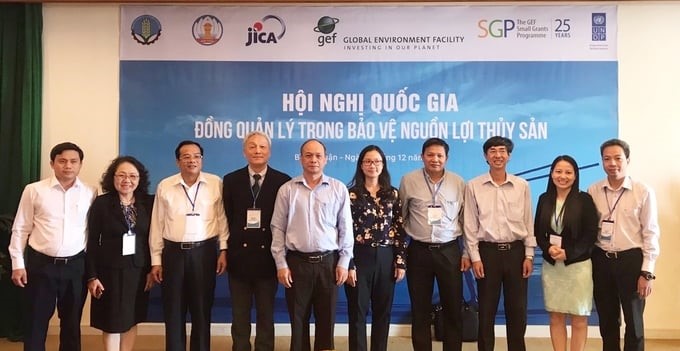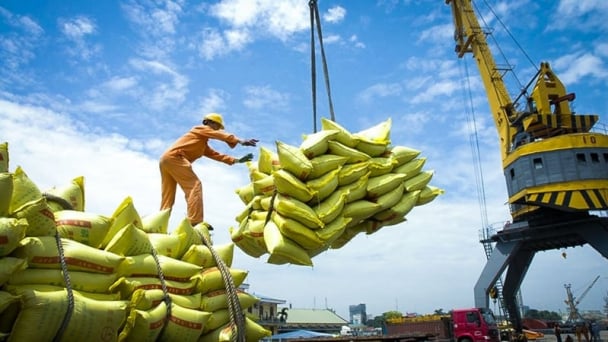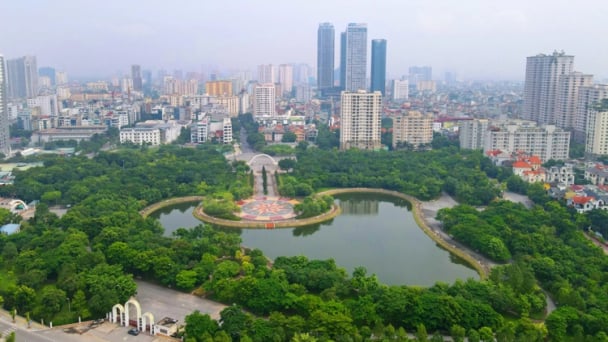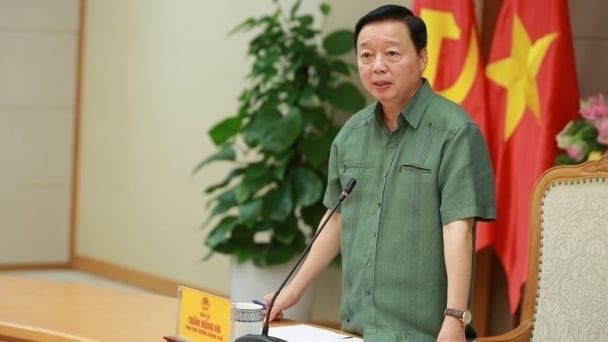May 22, 2025 | 13:44 GMT +7
May 22, 2025 | 13:44 GMT +7
Hotline: 0913.378.918
May 22, 2025 | 13:44 GMT +7
Hotline: 0913.378.918
The fisheries industry has been facing a number of problems and shortcomings. Specifically, the quantity of fishing vessels has not been controlled, and post-harvest losses in exploitation are still high. Illegal, unreported, and unregulated (IUU) fishing is still common, such as: using occupations that harm resources in coastal waters and offshore areas; fishing tools with mesh sizes smaller than prescribed; situations of immature individual exploitation that are quite common for most species; fishing in prohibited areas and times, etc.

Minister of Agriculture and Rural Development Le Minh Hoan spoke at the Dialogue "Promoting Co-Management for Sustainable and Responsible Fisheries" in Nha Trang city, Khanh Hoa.
These problems have been reducing aquatic resources and ecosystems in sea areas, especially coastal waters and inland areas. Environmental quality shows signs of decline, and conflicts occur within the seafood production sector as well as with other economic sectors such as tourism, industry, etc. Meanwhile, resources for management are limited in both human and material resources. These are challenges for the fisheries industry’s development.
However, practice shows that if only relying on the administrative apparatus, natural resource management cannot achieve the desired effect. The local resident community is the direct object of exploiting and using these valuable natural resources.
If the local resident community does not participate directly in the process of implementing state policies, does not participate in management, and only focuses on exploiting resources to make a living, it will be impossible to protect, conserve, and manage aquatic resources in a sustainable way.
To manage resources, aquatic resources, and ecosystems sustainably, it is impossible to rely only on state management; it is also necessary to rely on the community and share management responsibilities on the basis of harmonizing interests among stakeholders to manage and exploit aquatic resources responsibly and wisely. That is the method of co-management in protecting aquatic resources that we have implemented for many years.
In the world, models of aquatic resource co-management appeared in the 1960s. After the Convention on Biological Diversity was adopted at the Summit on Environment and Development organized by the United Nations in 1992 in Rio de Janeiro, Brazil, and officially took effect in December 1994, co-management models flourished and developed effectively in many countries in Asia, Africa, and Latin America.
As of now, the co-management method has been proven to be an effective solution in aquatic resource management and has been implemented in many countries around the world, such as Norway, Japan, South Korea, India, Thailand, Cambodia, the Philippines, Malaysia, etc.

Former Deputy Minister of Agriculture and Rural Development Vu Van Tam chaired the National Conference on Co-Management in Protecting Aquatic Resources in Binh Thuan province in 2017.
The Food and Agriculture Organization of the United Nations (FAO), the Southeast Asian Fisheries Development Center (SEAFDEC), and many other international organizations have recommended the widespread application of this management method in the fisheries industry, especially for countries with small-scale artisanal fisheries.
Co-management in fisheries was officially introduced into Vietnam in the 1990s with many different, rich, and diverse definitions and application methods. The process of researching and implementing co-management can be divided into the following periods:
Period 1990–2000:
Co-management in the fisheries sector has been researched and tested in Vietnam since the 1990s of the 20th century. With the efforts of research agencies and funding from international organizations, there have been a number of co-management models researched and tested in the fields of exploiting and protecting resources in different ecological regions and localities nationwide. For example, the model of fishing village in Cua Van village, Ha Long City, Quang Ninh, or the model of reservoir aquatic resource management at Thac Ba Lake (Yen Bai) within the framework of the Cooperation Program between the Ministry of Fisheries (formerly) and the WorldFish Center in 1993.
This period can be considered a groundbreaking initial phase in applying the co-management method in the fisheries industry. There are successes and failures, but they are all lessons for the process of applying the co-management method to exploiting, farming, and protecting aquatic resources with the participation of people.
Research in this period is also the foundation for the development of co-management in the fisheries industry and a premise for the next stage, and it has received the attention of leaders of the Ministry of Fisheries (formerly), localities, international organizations, scientists, donors, etc. to manage aquatic resources and ecosystems more effectively.
Period from 2000 to before the Law on Fisheries Law 2017
Many international organizations and non-governmental organizations have paid attention to and implemented community-based fisheries management models to develop aquatic resources sustainably and effectively.
In 2000, the Danish Government's Fisheries Sector Programme Support Phase I (FSPS I) had some initial activities in the SUMA Component (support for saline and brackish aquaculture) conducted at a number of aquaculture investment projects in the project's key provinces and initially brought certain effectiveness.
In 2001, with financial and technical support from the Center for Marinelife Conservation and Community Development (MCD), the community-based model participated in protecting 40 hectares of coral in the Ran Trao sea area, Van Hung commune, Van Ninh district, Khanh Hoa, with legal support from local government.
Since 2002, a community-based model has participated in protecting aquatic resources in the mangrove forest area of Phu Long commune (Cat Ba town, Hai Phong city), which is a self-governing community model of mangrove forest protection combined with sustainable aquaculture.
In 2005, the Fisheries Sector Programme Support Phase II (FSPS II) implemented the development of co-management models through the SCAFI (Strengthening of Capture Fisheries Management) Component, but mainly in the fields of aquatic exploitation and aquatic resource protection.
SCAFI has conducted many activities, including research, training, dissemination, coaching, establishing a technical consulting team, selecting locations, and implementing pilot models in 9 project provinces (Son La, Quang Ninh, Nghe An, Thua Thien Hue, Binh Dinh, Dak Lak, Ben Tre, An Giang, and Ca Mau).
Of which, the model of co-management in exploiting, farming, and protecting aquatic resources in Tam Giang Lagoon (Thua Thien Hue) was considered one of the first systematic co-management models in Vietnam. There, no groups or clubs of fishermen were established, but instead, fisheries branches of the provincial fisheries association were established in communes spread across the 22,000 hectares of lagoon.

Former Deputy Minister of Agriculture and Rural Development Vu Van Tam discussed with the Fishermen Community Association of Tan Thuan commune, Ham Thuan Nam district, Binh Thuan in 2017.
From 2013 to 2019, the Coastal Resources for Sustainable Development (CRSD) Project under the Ministry of Agriculture and Rural Development, with sponsorship from the World Bank, supported the establishment of 97 co-management groups, managing more than 800 km of coastline with more than 13,000 fishermen participating in implementation in 25 districts in 8 project provinces.
Co-management models have initially shown certain results, such as: awareness of the fishermen community about sustainable fishing, awareness of protecting aquatic resources, mastery of resources, and ability to self-govern were enhanced; destructive means of exploitation decreased; aquatic resources were gradually recovering, contributing to increasing income and stabilizing security and order in the community.
However, these models also had many shortcomings, such as: there was no legal basis for assigning the right to manage, exploit, cultivate, and protect aquatic resources to community organizations; there were no mechanisms or policies to support community groups in their initial stages of operation; there was a lack of implementation guidelines, selection of areas for co-management, monitoring, and evaluation of the models’ effectiveness; there was a lack of participation and synchronous coordination between parties, etc.
Co-management stipulated in the Law on Fisheries 2017 is a management method in which the state shares powers and responsibilities with community organizations participating in management in protecting aquatic resources, including aquaculture, aquatic resource exploitation, and entertainment tourism associated with fisheries activities in the area assigned management authority (Clause 4, Article 3, Point a, Clause 5, Article 10, Law on Fisheries).
Community organizations have the right to: organize and manage aquaculture activities; protect and exploit aquatic resources; and engage in entertainment tourism associated with fisheries activities in the assigned area. Carry out patrols and inspections of aquaculture activities, exploitation, protection, and development of aquatic resources in assigned areas, and request competent state agencies to handle violations. Prevent violations; be consulted; enjoy preferential and supportive policies; and establish Community Funds. People, associations, etc., have the right to participate with grassroots government in managing aquatic resource protection activities.
The 2017 Fisheries Law also emphasizes raising people's awareness and responsibility in protecting aquatic resources, gradually implementing the policy of socialization, and strengthening the role and responsibility of the community in management. Management of aquatic resource protection activities is an effective solution to reduce conflicts of interest in the community and contribute to the sustainable development of the fisheries industry.
At the same time, community organizations are responsible for complying with legal regulations on fisheries activities and organizing activities of exploitation, aquaculture, protection of aquatic resources, and ecotourism in accordance with operation regulations and plans for protecting and exploiting aquatic resources that the community commits to and is approved by.
Since 2019, co-management has been implemented in 7 provinces: Ha Tinh, Quang Nam, Binh Dinh, Phu Yen, Khanh Hoa, Binh Thuan, and Tuyen Quang, with 19 community organizations recognized and assigned the right to participate in co-management in protecting aquatic resources.
These are localities that have implemented and developed co-management on the basis of the Law on Fisheries and lessons learned from previous periods, such as: There is consensus, participation, and support from all levels of government, as well as coordination between local governments, local fisheries management agencies (the Sub-Department of Fisheries), resident communities, and relevant parties. The selection of core organizations to lead and mobilize the participation of the community and organizations is implemented. The fishermen community is truly involved in developing management regulations and plans for exploiting and protecting aquatic resources. The division of responsibilities and benefits among relevant parties as well as members of the community is implemented equally and transparently. Dissemination work must be carried out regularly.
Besides the successes that have been recorded, there are still many issues raised for co-management in the fisheries industry, such as: It is necessary to evaluate the effectiveness and replicate successful models for localities to learn from; review and amend legal documents; and develop policies to support the development of co-management and sustainable financial mechanisms to support and promote the effective implementation of co-management.

Members of the Community Group carry out work to protect the coral ecosystem.
Continue to disseminate the role, importance, and legal knowledge of co-management in protecting aquatic resources to all levels of government, people, and beneficiaries.
Enhance training on how to establish, operate, and effectively manage co-management groups for leaders of departments, sub-departments, districts, and communes with co-management in protecting aquatic resources. Establish a group of experts to guide and support localities during the implementation process.
Connect and mobilize the participation of businesses, scientists, managers, and community organizations to organize and develop closed dual livelihood models in a chain of activities ranging from aquaculture, exploitation and protection of aquatic resources, tourism, and entertainment associated with the area assigned management authority.
For localities, it is necessary to develop and implement the Project “Implementing Co-Management in Protecting Aquatic Resources,” as assigned by the Prime Minister in Decision 76/QD-TTg dated January 18, 2024, approving the National Program on Protecting and Developing Aquatic Resources.
This is an important basis for localities to implement synchronously and in accordance with reality in each locality. Only then will co-management in protecting aquatic resources truly bring effectiveness and harmonize benefits to both the state and the fishermen community. Aquatic resources and ecosystems will be restored. The income of the fishermen community will increase. Co-management also contributes to the fight against IUU fishing, promoting the motto “the industry implements, people check, people monitor, people benefit.”
Head of the Department of Aquatic Resources Protection and Development, Department of Fisheries Surveillance ; Translated by Huyen Vu Thu

(VAN) The draft amendment to the Circular on rice export trading stipulates a periodic reporting regime for rice exporting enterprises.

(VAN) Dong Thap farmers attained an average profit margin of 64% during the summer-autumn 2024 crop (first season), while An Giang and Kien Giang farmers followed with 56% and 54%, respectively.

(VAN) As a doctoral student doing research on renewable energy and electrification at Harvard University, the author shares his musings on electricity, nature, and countryside memories.

(VAN) The decree on Extended Producer Responsibility (EPR) ensures transparent management and disbursement of support funds, avoiding the creation of a “give-and-take” mechanism.

(VAN) Hue City rigorously enforces regulations regarding marine fishing and resource exploitation, with a particular emphasis on the monitoring of fishing vessels to prevent illegal, unreported, and unregulated (IUU) fishing.

(VAN) Hanoi People's Committee has issued a plan on reducing greenhouse gas emissions in the waste management sector with 2030 vision.

(VAN) Vietnam's draft amendment to Decree No. 156 proposes a mechanism for medicinal herb farming under forest canopies, linking economic development to population retention and the sustainable protection and development of forests.